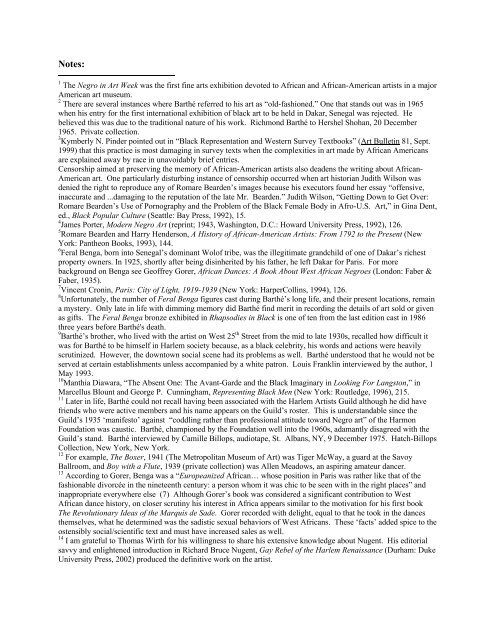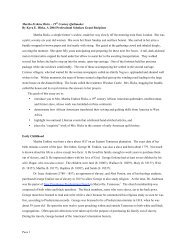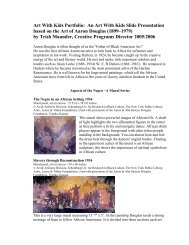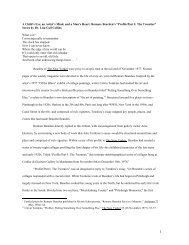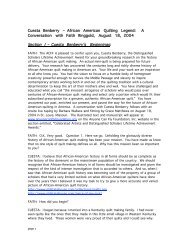Casting Feral Benga - The Anyone Can Fly Foundation, Inc.
Casting Feral Benga - The Anyone Can Fly Foundation, Inc.
Casting Feral Benga - The Anyone Can Fly Foundation, Inc.
You also want an ePaper? Increase the reach of your titles
YUMPU automatically turns print PDFs into web optimized ePapers that Google loves.
Notes:1 <strong>The</strong> Negro in Art Week was the first fine arts exhibition devoted to African and African-American artists in a majorAmerican art museum.2 <strong>The</strong>re are several instances where Barthé referred to his art as “old-fashioned.” One that stands out was in 1965when his entry for the first international exhibition of black art to be held in Dakar, Senegal was rejected. Hebelieved this was due to the traditional nature of his work. Richmond Barthé to Hershel Shohan, 20 December1965. Private collection.3 Kymberly N. Pinder pointed out in “Black Representation and Western Survey Textbooks” (Art Bulletin 81, Sept.1999) that this practice is most damaging in survey texts when the complexities in art made by African Americansare explained away by race in unavoidably brief entries.Censorship aimed at preserving the memory of African-American artists also deadens the writing about African-American art. One particularly disturbing instance of censorship occurred when art historian Judith Wilson wasdenied the right to reproduce any of Romare Bearden’s images because his executors found her essay “offensive,inaccurate and ...damaging to the reputation of the late Mr. Bearden.” Judith Wilson, “Getting Down to Get Over:Romare Bearden’s Use of Pornography and the Problem of the Black Female Body in Afro-U.S. Art,” in Gina Dent,ed., Black Popular Culture (Seattle: Bay Press, 1992), 15.4 James Porter, Modern Negro Art (reprint; 1943, Washington, D.C.: Howard University Press, 1992), 126.5 Romare Bearden and Harry Henderson, A History of African-American Artists: From 1792 to the Present (NewYork: Pantheon Books, 1993), 144.6 <strong>Feral</strong> <strong>Benga</strong>, born into Senegal’s dominant Wolof tribe, was the illegitimate grandchild of one of Dakar’s richestproperty owners. In 1925, shortly after being disinherited by his father, he left Dakar for Paris. For morebackground on <strong>Benga</strong> see Geoffrey Gorer, African Dances: A Book About West African Negroes (London: Faber &Faber, 1935).7 Vincent Cronin, Paris: City of Light, 1919-1939 (New York: HarperCollins, 1994), 126.8 Unfortunately, the number of <strong>Feral</strong> <strong>Benga</strong> figures cast during Barthé’s long life, and their present locations, remaina mystery. Only late in life with dimming memory did Barthé find merit in recording the details of art sold or givenas gifts. <strong>The</strong> <strong>Feral</strong> <strong>Benga</strong> bronze exhibited in Rhapsodies in Black is one of ten from the last edition cast in 1986three years before Barthé's death.9 Barthé’s brother, who lived with the artist on West 25 th Street from the mid to late 1930s, recalled how difficult itwas for Barthé to be himself in Harlem society because, as a black celebrity, his words and actions were heavilyscrutinized. However, the downtown social scene had its problems as well. Barthé understood that he would not beserved at certain establishments unless accompanied by a white patron. Louis Franklin interviewed by the author, 1May 1993.10 Manthia Diawara, “<strong>The</strong> Absent One: <strong>The</strong> Avant-Garde and the Black Imaginary in Looking For Langston,” inMarcellus Blount and George P. Cunningham, Representing Black Men (New York: Routledge, 1996), 215.11 Later in life, Barthé could not recall having been associated with the Harlem Artists Guild although he did havefriends who were active members and his name appears on the Guild’s roster. This is understandable since theGuild’s 1935 ‘manifesto’ against “coddling rather than professional attitude toward Negro art” of the Harmon<strong>Foundation</strong> was caustic. Barthé, championed by the <strong>Foundation</strong> well into the 1960s, adamantly disagreed with theGuild’s stand. Barthé interviewed by Camille Billops, audiotape, St. Albans, NY, 9 December 1975. Hatch-BillopsCollection, New York, New York.12 For example, <strong>The</strong> Boxer, 1941 (<strong>The</strong> Metropolitan Museum of Art) was Tiger McWay, a guard at the SavoyBallroom, and Boy with a Flute, 1939 (private collection) was Allen Meadows, an aspiring amateur dancer.13 According to Gorer, <strong>Benga</strong> was a “Europeanized African… whose position in Paris was rather like that of thefashionable divorcée in the nineteenth century: a person whom it was chic to be seen with in the right places” andinappropriate everywhere else (7) Although Gorer’s book was considered a significant contribution to WestAfrican dance history, on closer scrutiny his interest in Africa appears similar to the motivation for his first book<strong>The</strong> Revolutionary Ideas of the Marquis de Sade. Gorer recorded with delight, equal to that he took in the dancesthemselves, what he determined was the sadistic sexual behaviors of West Africans. <strong>The</strong>se ‘facts’ added spice to theostensibly social/scientific text and must have increased sales as well.14 I am grateful to Thomas Wirth for his willingness to share his extensive knowledge about Nugent. His editorialsavvy and enlightened introduction in Richard Bruce Nugent, Gay Rebel of the Harlem Renaissance (Durham: DukeUniversity Press, 2002) produced the definitive work on the artist.


